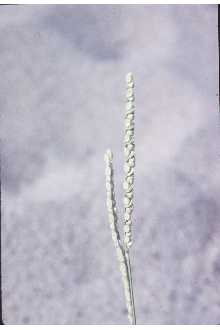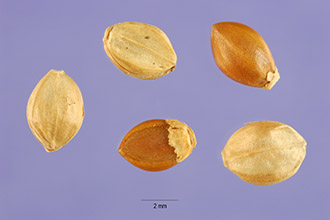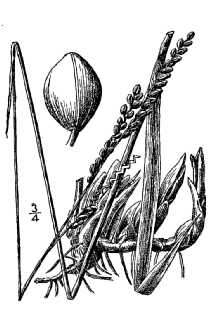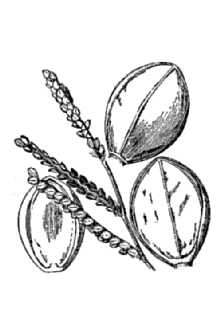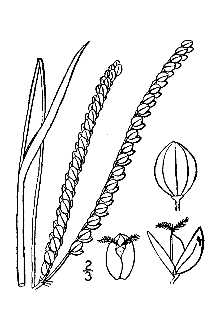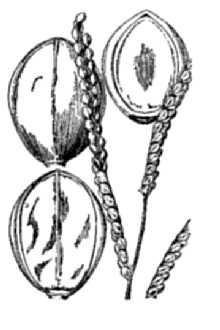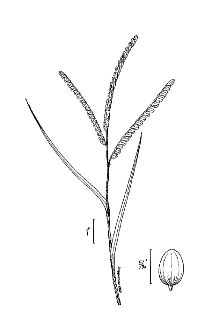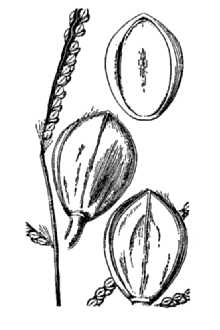Paspalum difforme Leconte
Scientific Name: Paspalum difforme Leconte
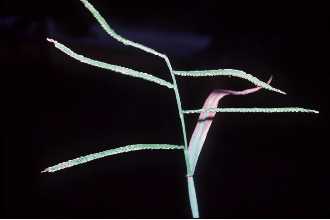
| General Information | |
|---|---|
| Usda Symbol | PADI4 |
| Group | Monocot |
| Life Cycle | Perennial |
| Growth Habits | Graminoid |
| Native Locations | PADI4 |
Plant Guide
Alternate Names
Paspalum difforme Le Conte Paspalum floridanum Michx. var. glabratum Engelm. ex Vasey Paspalum giganteum Baldw. ex Vasey Paspalum glabratum (Engelm. ex Vasey) C. Mohr
Uses
Forage: “Florida paspalum is palatable and is readily grazed by cattle during its growing season. Because this grass is succulent, it deteriorates rapidly after maturity, making it unimportant as dry winter forage” (Leithead, Yarlett and Shiflet, 1971). Young leaves are palatable and nutritious, becoming less so as the plant matures. In a native warm- season grass forage trial in Maryland, Florida paspalum exhibited good seedling vigor and stand establishment, excellent tolerance to drought, and good initial yields (Ugiansky, R.J., L. Vough, and E. Dengler, 2008). Erosion Control: Florida paspalum is a versatile grass that readily grows on disturbed areas such as road ditches as well as on sandy or poorly drained sites. Being well adapted to wet soils, it is suitable for use along vegetated swales or waterways. The bluish color of some foliage gives this species some ornamental character. Wildlife: Florida paspalum produces an abundance of large grain-like seed which is eaten by birds including quail, dove, and turkey. Wildlife, especially game birds, use Florida paspalum for both food and cover (Grelen and Hughs, 1984). Seeds mature over an extended period of time, with an initial flush in late August and continuing until frost, providing wildlife with a dependable source of food from late summer into winter.
Status
Please consult the PLANTS Web site and your State Department of Natural Resources for this plant’s current status (e, Use soil moisture sensors to measure the soil moisture of Paspalum difforme Leconte.,g,, threatened or endangered species, state noxious status, and wetland indicator values),
Description
General: Florida paspalum is a native warm-season, perennial rhizomatous grass, typically ranging in height from 3 to 5 feet and up to 8 feet with higher fertility. Plants are bunch-like but slowly spread from short, thick rhizomes forming a sod over time, especially under grazing. New growth begins in early spring. Plants may be dark green or have a chalky cast that gives a bluish appearance. Leaf sheaths and leaf blades may have short coarse hairs or may be hairless. The leaf blades are firm, flat or folded, approximately 3/8” to 3/4” wide and 14” to 20” long, with a dense tuft of long hairs immediately above the ligule. Leaf sheaths are open, rounded, and frequently covered in hair (Leithead, Yarlett and Shiflet, 1971). The seeds heads are similar in appearance to other paspalum species, although with generally larger seed than most. Seeds are half-rounded and smooth and are crowded pairs along either side of the branches. The seed heads have 2 to 6 branches (racemes) that are each 3” to 4” long. Florida paspalum produces an abundance of large seed that mature over an extended period of time from late summer to late fall as new seed heads are continually produced from late July until frost. Habitat: Florida paspalum is commonly found growing in grassy areas and wood openings, with low, moist, sandy soil and along fresh or brackish marshes. Distribution: Florida paspalum’s native range is from Pennsylvania and New Jersey south to Florida, west to Kansas, Oklahoma and Texas. For current distribution, please consult the Plant Profile page for this species on the PLANTS Web site.
Adaptation
Florida paspalum is adapted to most, acid to neutral soils in the eastern US. It is also adapted to sandy well-drained, deep, upland soils with underlying fine textured soils (Leithead, Yarlett and Shiflet, 1971).
Establishment
Florida paspalum establishes quite easily from seed compared to many other warm-season grasses. Seedlings are vigorous and compete well with concurrently germinating weeds, establishing well in the first growing season with adequate moisture and fertility. Florida paspalum can be seeded in a pure stand or in a mix of other species with a seeding depth of 1/4” on fine textured soils and up to 3/4” on coarse textured soils. The smooth seed can be planted with most seed drills or broadcast seeded into a prepared firm seedbed. It is recommended to firm the seedbed after seeding with a roller or culti-packer. General seeding recommendations are 6 to 8 pounds PLS per acre for most applications. Seeds are large and light with approximately 91,000 seeds/lb. With adequate moisture, most seeds will germinate within 7 days. If needed control any tall weeds that shade the seedlings in the first growing season by mowing at a height of 6 to 8 inches. Good moisture and nutrient availability will enhance establishment. Additional nitrogen, at a rate 30 to 60 pounds per acre, may be applied to pure stands to increase growth, but this increased growth and competitiveness may not be desirable for mixed stands. Freshly harvested seed has a high degree of dormancy which is reduced as the seed ages. Ambient (room) temperature storage reduces dormancy better than cold stratification treatment, with the best germination attained after 9 months of ambient storage (Brakie, M., J. Stevens, and J. Douglas, 2008). Cold storage reduces seed dormancy less quickly, requiring a minimum of 3 years of cold storage to reduce seed dormancy (Brakie, M., J. Stevens, and J. Douglas, 2006).
Management
Florida paspalum will begin growth earlier in the spring and have increased vigor if thatch is mowed or burned in late winter to early spring. Florida paspalum responds well to burning and tolerates repeated cutting. Stems and leaves of Florida paspalum are relatively soft and will fall over and break down more quickly over the winter than other tall warm-season grasses such as switchgrass.
Pests and Potential Problems
Florida Paspalum appears to be relatively free of significant disease or pests problems. Stem and leaf rusts appear to be much less of a problem than on many other warm-season grasses in wet years. Leaves generally have a very healthy clean appearance.
Seeds and Plant Production
Plant Production
Plant Production
Plants are highly fertile and do not require cross pollination with unrelated individuals to achieve good seed set like many other warm-season grasses often require. Jessup (2007) has demonstrated that Florida paspalum is a meiotically irregular polyploid with about 160 chromosomes that analysis suggests reproduces by facultative apomixes. This means that seedlings are for the most part are genetically identical to the plant that produced the seed. Seeds are produced in abundance but shatter somewhat easily making harvest timing difficult. When the first seed heads mature there are also younger seed heads present at all stages of development, making harvest with a combine somewhat problematic. Two harvests may be obtained if the first harvest is done early and cut above newly emerging seed heads and then harvested again about a month later. More than two harvests may be made with a seed stripper type harvester, but care should be taken to allow for enough clearance of equipment over the plants to minimize breaking the easily damages stems. Cultivars, Improved, and Selected Materials (and area of origin) Harrison germplasm Florida paspalum was released in 2004 by the East Texas Plant Materials Center in Nacogdoches, Texas. The seed for this release was originally collected from a native stand in Harrison County, Texas by Paul Leggett and Ross Brown of NRCS. Harrison Germplasm Florida paspalum is recommended for wildlife food/cover, mine reclamation, prairie restoration, and a component of native grass forage mixes. Mid-Atlantic germplasm Florida paspalum was released in 2009 by the Norman A. Berg National Plant Materials Center in Beltsville, Maryland. It consists of a composite increase of nine collections from Maryland, New Jersey and Delaware. It is recommended for soil stabilization, filter strips, meadow plantings, wildlife food and cover as well as for forage, especially in wet soils.
Fact Sheet
Alternate Names
Paspalum difforme Le Conte, Paspalum floridanum Michx. var. glabratum Engelm. ex Vasey, Paspalum giganteum Baldw. ex Vasey, Paspalum glabratum (Engelm. ex Vasey) C. Mohr
Uses
Livestock: Young leaves are palatable and nutritious becoming less so as plant matures, Erosion Control: Paspalum is a versatile grass that readily grows on disturbed areas such as road ditches as well as on sandy or poorly drained sites, The bluish color of some foliage gives this species ornamental characteristics as well, Wildlife: Quail, dove, and turkey all eat the large grain-like seeds, , Use soil moisture sensors to measure the soil moisture of Paspalum difforme Leconte.
Status
Please consult the PLANTS Web site and your State Department of Natural Resources for this plant’s current status (e.g. threatened or endangered species, state noxious status, and wetland indicator values).
Description
Paspalum floridanum Michx., Florida paspalum, is a native warm-season (C4) perennial bunch grass. It is tall, ranging in height from 3 to 6 feet and spreads from short, thick rhizomes or seed. Leaf sheaths and leaf blades range in color from dark green to a bluish, chalky cast with short coarse hairs or hairless. The leaf blades are firm, flat or folded, approximately 3/8” wide and 20” long, with a dense tuft of long hairs immediately above the ligule. The seed heads have 2 to 5 branches with half-rounded smooth seeds that occur in pairs. Seeds are crowded along the branches. Florida paspalum sets seed in late summer that matures in late fall.
Adaptation and Distribution
Distribution
Distribution
Florida paspalum’s native range is from Pennsylvania and Delaware south to Florida, west to Missouri, Oklahoma and Texas. It is adapted to most eastern US soils and is commonly found growing in low, moist, grassy areas, and wood openings. For a current distribution map, please consult the Plant Profile page for this species on the PLANTS Website.
Establishment
Florida paspalum can be seeded in a pure stand or in a mix of other species with a seeding depth of ¼” to ¾”. The smooth seed can be planted with most seed drills or broadcast seeded into a firm seedbed. Florida paspalum establishes readily from seed with little to no stratification. Seedling vigor is good and establishes well in the first growing season. General seeding recommendations are 6 to 8 pounds PLS per acre for most applications. Seeds are large and light with approximately 91,000 seeds/lb.

